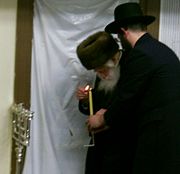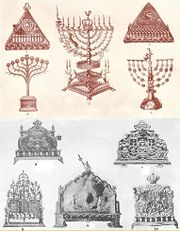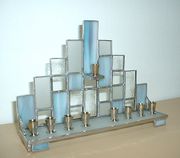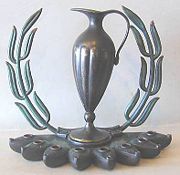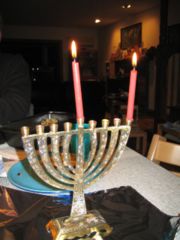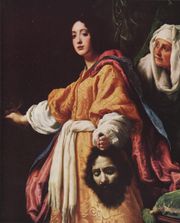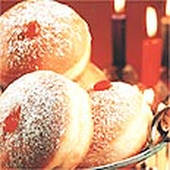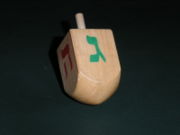Hanukkah
2008/9 Schools Wikipedia Selection. Related subjects: Religious movements, traditions and organizations
| Hanukkah | |
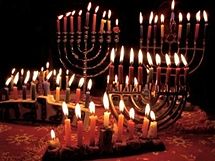 Several Menorot on the eighth night of the festival. |
|
| Official name | Hebrew: חֲנֻכָּה or חנוכה English translation: "Establishing/Dedication" (of the Temple in Jerusalem) |
|---|---|
| Also called | Festival of Lights, Festival of Dedication |
| Observed by | Jews |
| Type | Jewish |
| Significance | The Maccabees successfully rebelled against Antiochus IV Epiphanes. The Temple was purified and the wicks of the menorah miraculously burned for eight days. |
| Begins | 25 Kislev |
| Ends | 2 Tevet or 3 Tevet |
| 2008 date | sunset, December 21 to sunset, December 29 The first Day of Hanukkah 2008 is December 22. |
| 2009 date | sunset, December 11 to sunset, December 19 |
| Celebrations | Lighting candles each night. Singing special songs, such as Ma'oz Tzur. Reciting Hallel prayer. Eating festive meals and foods fried in oil, such as latkes and sufganiyot. Playing the dreidel game, and giving Hanukkah gelt |
| Related to | Purim, as a rabbinically decreed holiday. |
Hanukkah (Hebrew: חנוכה, alt. Chanukah), also known as the Festival of Lights, is an eight-day Jewish holiday commemorating the rededication of the Second Temple in Jerusalem at the time of the Maccabean Revolt of the 2nd century BCE. Hanukkah is observed for eight nights, starting on the 25th day of Kislev according to the Hebrew calendar, and may occur from late November to late December on the Gregorian calendar.
The festival is observed by the kindling of the lights of a special candelabrum, the Menorah or Hanukiah, one light on each night of the holiday, progressing to eight on the final night. An extra light called a shamash, (Hebrew: "guard" or "servant") is also lit each night, and is given a distinct location, usually higher or lower than the others. The purpose of the extra light is to adhere to the prohibition, specified in the Talmud (Tracate Shabbat 21b-23a), against using the Hanukkah lights for anything other than publicizing and meditating on the Hanukkah story.
Hanukkah is mentioned in the deuterocanonical or apocrypha books of 1 Maccabees and 2 Maccabees. 1 Maccabees states: "For eight days they celebrated the rededication of the altar. Then Judah and his brothers and the entire congregation of Israel decreed that the days of the rededication...should be observed...every year...for eight days. (1 Mac.4:56-59)" According to 2 Maccabees, "the Jews celebrated joyfully for eight days as on the feast of Booths."
Origins of the holiday
"Hanukkah," from the Hebrew word for "dedication" or "consecration", marks the re-dedication of the Temple in Jerusalem after its desecration by the forces of Antiochus IV and commemorates the "miracle of the container of oil." According to the Talmud, at the re-dedication following the victory of the Maccabees over the Seleucid Empire, there was only enough consecrated olive oil to fuel the eternal flame in the Temple for one day. Miraculously, the oil burned for eight days, which was the length of time it took to press, prepare and consecrate fresh olive oil.
Hanukkah is also mentioned in the deuterocanonical books of 1 Maccabees and 2 Maccabees. 1 Maccabees states: "For eight days they celebrated the rededication of the altar. Then Judah and his brothers and the entire congregation of Israel decreed that the days of the rededication...should be observed...every year...for eight days. (1 Mac.4:56-59)" According to 2 Maccabees, "the Jews celebrated joyfully for eight days as on the feast of Booths."
The martyrdom of Hannah and her seven sons has also been linked to Hanukkah. According to the Talmudic story and 2 Maccabees, a Jewish woman named Hannah and her seven sons were tortured and executed by Antiochus' for refusing to bow down to a statue and eat pork, in violation of Jewish law.
Name
The name "Hanukkah" is interpreted in many ways.
- Some scholars say the word was derived from the Hebrew verb "חנך" meaning "to dedicate" or to "educate." On Hanukkah,Jews mark the rededication of the House of the Lord.
- Others argue that the name can be broken down into "חנו", from the Hebrew word for encampment, and the Hebrew letters כ"ה, which stand for the 25th day of Kislev, the day on which the holiday begins: Hence, the Jews sat in their camp, that is, they rested fighting, on the 25th day of Kislev.
- Hanukkah is also the Hebrew acronym for "ח' נרות והלכה כבית הלל" meaning "eight candles as determined by House of Hillel" This is a reference to the disagreement between two rabbinical schools of thought - Hillel and the House of Shammai - on the proper way to light Hanukkah candles. Shammai said that eight candles should be lit from the start, and reduced by one candle every night, whereas Hillel argued in favour of starting with one candle and lighting an additional one every night. Jewish law adopted the position of Hillel.
The story
Around 200 BCE Jews lived as an autonomous people in the Land of Israel, also referred to as Judea, which at that time was controlled by the Seleucid king of Syria. The Jewish people paid taxes to Syria and accepted its legal authority, and they were free to follow their own faith, maintain their own jobs, and engage in trade.
By 175 BCE Antiochus IV Epiphanes ascended to the Seleucid throne. At first little changed, but under his reign, the Temple in Jerusalem was looted, Jews were massacred, and Judaism was effectively outlawed. In 167 BCE Antiochus ordered an altar to Zeus erected in the Temple.
Many modern scholars argue that the king may have been intervening in an internal civil war between the traditionalist Jews in the country and the Hellenized elite Jews in Jerusalem. These competed violently over who would be the High Priest, with traditionalists with Hebrew/Aramaic names like Onias overthrown by Hellenizers with Greek names like Jason and Menelaus. As the conflict escalated, Antiochus took the side of the Hellenizers by prohibiting the religious practices the traditionalists had rallied around. This may explain why the king, in a total departure from Seleucid practice in all other places and times, banned the traditional religion of a whole people.
Antiochus' actions proved to be a major miscalculation as they provoked a large-scale revolt. Mattathias, a Jewish priest, and his five sons Jochanan, Simeon, Eleazar, Jonathan, and Judah led a rebellion against Antiochus. Judah became known as Yehuda HaMakabi ("Judah the Hammer"). By 166 BCE Mattathias had died, and Judah took his place as leader. By 165 BCE the Jewish revolt against the Seleucid monarchy was successful. The Temple was liberated and rededicated. The festival of Hanukkah was instituted by Judah Maccabee and his brothers to celebrate this event. After recovering Jerusalem and the Temple, Judah ordered the Temple to be cleansed, a new altar to be built in place of the polluted one and new holy vessels to be made. According to the Talmud, olive oil was needed for the menorah in the Temple, which was required to burn throughout the night every night. But there was only enough oil to burn for one day, yet miraculously, it burned for eight days, the time needed to prepare a fresh supply of oil for the menorah. An eight day festival was declared by the Jewish sages to commemorate this miracle.
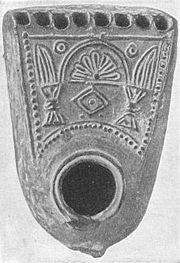
The version of the story in 1 Maccabees, on the other hand, states that an eight day celebration of songs and sacrifices was proclaimed upon rededication of the altar, and makes no mention of the miracle of the oil. A number of historians believe that the reason for the eight day celebration was that the first Hanukkah was in effect a belated celebration of the festivals of Sukkot and Shemini Atzeret. During the war the Jews were not able to celebrate Sukkot/Shemini Atzeret properly; the combined festivals also last eight days, and the Sukkot festivities featured the lighting of lamps in the Temple (Suk.v. 2-4). The historian Josephus mentions the eight-day festival and its customs, but does not tell us the origin of the eight day lighting custom. Given that his audience was Hellenized Romans, perhaps his silence on the origin of the eight-day custom is due to its miraculous nature. In any event, he does report that lights were kindled in the household and the popular name of the festival was, therefore the "Festival of Lights" ("And from that time to this we celebrate this festival, and call it Lights").
It has also been noted that the number eight has special significance in Jewish theology, as representing transcendence and the Jewish People's special role in human history. Seven is the number of days of creation, that is, of completion of the material cosmos, and also of the classical planets. Eight, being one step beyond seven, represents the Infinite. Hence, the Eighth Day of the Assembly festival, mentioned above, is according to Jewish Law a festival for Jews only (unlike Sukkot, when all peoples were welcome in Jerusalem). Similarly, the rite of brit milah (circumcision), which brings a Jewish male into God's Covenant, is performed on the eighth day. Hence, Hanukkah's eight days (in celebration of monotheistic morality's victory over Hellenistic humanism) have great symbolic importance for practicing Jews.
Hanukkah rituals
Hanukkah is celebrated by a series of rituals that are performed every day throughout the 8-day holiday. Some are family-based and others are communal. There are special additions to the daily prayer service, and a section is added to the blessing after meals. Hanukkah is not a "Sabbath-like" holiday, and there is no obligation to refrain from activities that are forbidden on the Sabbath, as specified in the Shulkhan Arukh People go to work as usual, but may leave early in order to be home to kindle the lights at nightfall. There is no religious reason for schools to be closed, although, in Israel, schools close for the whole week of Hanukkah.
Kindling the Hanukkah lights
The primary ritual, according to Jewish law and custom, is to light a single light each night for eight nights. As a universally practiced "beautification" of the mitzvah, the number of lights lit is increased by one each night. An extra light called a shamash, meaning guard or servant is also lit each night, and is given a distinct location, usually higher or lower than the others. The purpose of the extra light is to adhere to the prohibition, specified in the Talmud (Tracate Shabbat 21b-23a), against using the Hanukkah lights for anything other than publicizing and meditating on the Hanukkah story. This differs from Sabbath candles which are meant to be used for illumination. Hence, if one were to need extra illumination on Hanukkah, the shamash candle would be available and one would avoid using the prohibited lights. Some light the shamash candle first and then use it to light the others. So all together, including the shamash, two lights are lit on the first night, three on the second and so on, ending with nine on the last night, for a total of 44.
The lights can be candles or oil lamps. Electric lights are sometimes used and are acceptable in places where open flame is not permitted, such as a hospital room. Most Jewish homes have a special candelabrum or oil lamp holder for Hanukkah, which holds eight lights plus the additional shamash light.
The reason for the Hanukkah lights is not for the "lighting of the house within", but rather for the "illumination of the house without," so that passers-by should see it and be reminded of the holiday's miracle. Accordingly lamps are set up at a prominent window or near the door leading to the street. It is customary amongst some Ashkenazim to have a separate menorah for each family member (customs vary), whereas most Sephardim light one for the whole household. Only when there was danger of anti-semitic persecution were lamps supposed to be hidden from public view, as was the case in Persia under the rule of the Zoroastrians, or in parts of Europe before and during World War II. However, most Hasidic groups, light lamps near an inside doorway, not necessarily in public view. According to this tradition, the lamps are placed on the opposite side from the mezuzah, so that when one passes through the door he is surrounded by the holiness of mitzvoth.
When to light the lights
Hanukkah lights should burn for at least one half hour after it gets dark. The custom of the Vilna Gaon observed by many residents of Jerusalem as the custom of the city, is to light at sundown, although most Hassidim light later, even in Jerusalem. Many Hasidic Rebbes light much later, because they fulfill the obligation of publicizing the miracle by the presence of their Hasidim when they kindle the lights. Inexpensive small wax candles sold for Hanukkah burn for approximately half an hour, so on most days this requirement can be met by lighting the candles when it is dark outside. Friday night presents a problem, however. Candles must be lit before the start of Shabbat and inexpensive Hanukkah candles do not burn long enough to meet the requirement. A simple solution is to use longer candles, arranging them in a straight line and setting the shamash candle apart and above the rest, or by using the traditional oil lamps.
Blessings over the candles
Typically three blessings (Brachot singular Brachah) are recited during this eight-day festival. On the first night of Hanukkah, Jews recite all three blessings, on all subsequent nights, they recite only the first two. The blessings are said before or after the candles are lit depending on tradition. On the first night of Hanukkah one light (candle, lamp, or electric) is lit on the right side of the Menorah, on the following night a second light is placed to the left of the first candle and so on, proceeding from right to left each night.
The first blessing
Recited on all eight nights prior to lighting the menorah:
| Hebrew | English | Transliteration |
|---|---|---|
| 'בָּרוּךְ אַתָה ה | Blessed are You, | Baruch atah Adonai |
| אֶלוֹהֵינוּ מֶלֶךְ הַעוֹלָם | Lord our God, King of the universe, | Eloheinu Melech ha'o'lam |
| אֲשֶׁר קִדְּשָׁנוּ בְּמִצְוֹתָיו | Who sanctified us with His commandments | asher kid'shanu b'mitzvotav |
| וְצִוָּנוּ לְהַדְלִיק נֵר (שֶל) חֲנֻכָּה | and commanded us to kindle the Chanukah lights." | v'tzivanu l'hadlik neir (shel) chanukah . |
The second blessing
Recited on all eight nights prior to lighting the menorah:
| Hebrew | English | Transliteration |
|---|---|---|
| 'בָּרוּךְ אַתָה ה | Blessed are You, | Baruch atah Adonai |
| אֶלוֹהֵינוּ מֶלֶךְ הַעוֹלָם | Lord our God, King of the universe, | Eloheinu Melech ha'o'lam |
| שֶׁעָשָׂה נִסִּים לַאֲבוֹתֵינוּ | Who performed wondrous deeds for our ancestors, | she-asah nisim la-avoteinu, |
| בַּיָמִים הָהֵם בַּזְּמַן הַזֶּה | in those days, at this moment. | bayamim haheim, (u)baz'man hazeh. |
The third blessing
Recited only on the first night prior to lighting the menorah:
| Hebrew | English | Transliteration |
|---|---|---|
| 'בָּרוּךְ אַתָה ה | Blessed are You, | Baruch atah Adonai |
| אֶלוֹהֵינוּ מֶלֶךְ הַעוֹלָם | Lord our God, King of the universe, | Eloheinu Melech ha'o'lam |
| שֵהֵחְיָנוּ וְקִיְימָנוּ | Who has kept us in life, sustained us, | sheh'heh'cheh'ya'nu veh'ki'yeh'ma'nu |
| וְהִגִעָנוּ לַזְמַן הַזֶה | and brought us to this moment. | veh'he'g'a'nu laz'man ha'zeh. |
After kindling the lights - Hanerot Halalu
During or after the lights are kindled the Hanerot Halalu prayer is recited. There are several differing versions - the version presented here is recited in many Ashkenazic communities:
| Ashkenazic version: | |
|---|---|
| Transliteration | English |
| Hanneirot hallalu anachnu madlikin 'al hannissim ve'al hanniflaot 'al hatteshu'ot ve'al hammilchamot she'asita laavoteinu bayyamim haheim, (u)bazzeman hazeh 'al yedei kohanekha hakkedoshim. Vekhol-shemonat yemei Hanukkah hanneirot hallalu kodesh heim, ve-ein lanu reshut lehishtammesh baheim ella lir'otam bilvad kedei lehodot ul'halleil leshimcha haggadol 'al nissekha ve'al nifleotekha ve'al yeshu'otekha | We light these lights for the miracles and the wonders, for the redemption and the battles that you made for our forefathers, in those days at this season, through your holy priests. During all eight days of Hanukkah these lights are sacred, and we are not permitted to make ordinary use of them except for to look at them in order to express thanks and praise to Your great Name for your miracles, Your wonders and Your salvations. |
Singing of Maoz Tzur after lighting
Each night after the lighting of the candles, while remaining within sight of the candles, Ashkenazim (and, in recent decades, some Sephardim and Mizrahim in Western countries) usually sing the hymn Ma'oz Tzur written in Medieval Germany. The song contains six stanzas. The first and last deal with general themes of divine salvation, and the middle four deal with events of persecution in Jewish history, and praises God for survival despite these tragedies (the the exodus from Egypt, the Babylonian captivity, the miracle of the holiday of Purim, and the Hasmonean victory).
Other customs
After lighting the candles and Ma'oz Tzur, singing various other Hanukkah songs is customary in many Jewish homes. Various Hasidic and Sefardic traditions have additional prayers that are recited both before and after lighting the Hanukkah lights. This includes the recitation of many Psalms, most notably Psalms 30, 67, and 91 (many Hasidim recite Psalm 91 seven times after lighting the lamps, as was taught by the Baal Shem Tov), as well as other prayers and hymns, each congregation according to its own custom. In North America it is common to exchange presents or give children presents at this time.
Additions to the daily prayers
| "We thank You also for the miraculous deeds and for the redemption and for the mighty deeds and the saving acts wrought by You, as well as for the wars which You waged for our ancestors in ancient days at this season. In the days of the Hasmonean Mattathias, son of Johanan the high priest, and his sons, when the iniquitous Greco-Syrian kingdom rose up against Your people Israel, to make them forget Your Torah and to turn them away from the ordinances of Your will, then You in your abundant mercy rose up for them in the time of their trouble, pled their cause, executed judgment, avenged their wrong, and delivered the strong into the hands of the weak, the many into the hands of few, the impure into the hands of the pure, the wicked into the hands of the righteous, and insolent ones into the hands of those occupied with Your Torah. Both unto Yourself did you make a great and holy name in Thy world, and unto Your people did You achieve a great deliverance and redemption. Whereupon your children entered the sanctuary of Your house, cleansed Your temple, purified Your sanctuary, kindled lights in Your holy courts, and appointed these eight days of Hanukkah in order to give thanks and praises unto Your holy name." Translation of Al ha-Nissim |
An addition is made to the "hoda'ah" (thanksgiving) benediction in the Amidah, called Al ha-Nissim ("On/about the Miracles"). This addition refers to the victory achieved over the Syrians by the Hasmonean Mattathias and his sons.
The same prayer is added to the grace after meals. In addition, the Hallel Psalms are sung during each morning service and the Tachanun penitential prayers are omitted. The Torah is read every day in the synagogue, the first day beginning from Numbers 6:22 (According to some customs, Numbers 7:1), and the last day ending with Numbers 8:4.
Since Hanukkah lasts eight days it includes at least one, and sometimes two, Jewish Sabbaths (Saturdays). The weekly Torah portion for the first Sabbath is almost always Miketz, telling of Joseph's dream and his enslavement in Egypt. The Haftarah reading for the first Sabbath Hanukkah is Zechariah 2:14-4:7. When there is a second Sabbath on Hanukkah, the Haftarah reading is from I Kings 7:40 - 7:50.
The Hanukkah menorah is also kindled daily in the synagogue, at night with the blessings and in the morning without the blessings. The menorah is not lit on the Sabbath, but rather prior to the beginning of the Sabbath at night and not at all during the day.
During the Middle Ages " Megillat Antiochus" was read in the Italian synagogues on Hanukkah just as the Book of Esther is read on Purim. It still forms part of the liturgy of the Yemenite Jews.
Zot Hanukkah
The last day of Hanukkah is known as Zot Hanukkah, from the verse in the Book of Numbers 7:84 "Zot Chanukat Hamizbe'ach" - "This was the dedication of the altar", which is read on this day in the synagogue. According to the teachings of Kabbalah and Hasidism, this day is the final "seal" of the High Holiday season of Yom Kippur, and is considered a time to repent out of love for God. In this spirit, many Hasidic Jews wish each other "Gmar chatimah tovah", "may you be sealed totally for good", a traditional greeting for the Yom Kippur season. It is taught in Hasidic and Kabbalistic literature that this day is particularly auspicious for the fulfillment of prayers.
Judith and Holofernes
Eating dairy foods, especially cheese, on Hanukkah is a minor custom that has its roots in the story of Judith, as related in the book of Judith (Yehudit or Yehudis in Hebrew). Holofernes, an Assyrian general, had surrounded the village of Bethulia as part of his campaign to conquer Judea. After intense fighting, the water supply of the Jews is cut off and the situation became desperate. Judith, a pious widow, told the city leaders that she had a plan to save the city. Judith went to the Assyrian camps and pretended to surrender. She met Holofernes, who was smitten by her beauty. She went back to his tent with him, where she plied him with cheese and wine. When he fell into a drunken sleep, Judith beheaded him and escaped from the camp, taking the severed head with her. When Holofernes' soldiers found his corpse, they were overcome with fear; the Jews, on the other hand, were emboldened, and launched a successful counterattack. The town was saved, and the Assyrians defeated.
Many argue that Holofernes was actually Greek, placing the events in the general time-frame of Hanukkah. The longstanding tradition that Judith was the daughter of Yochanan the High Priest, and consequently a sister of Mattathias the Hasmonean and an aunt of Judah the Maccabee, is how this story came to be associated with Hanukkah. There are many depictions of Judith and Holofernes in painting.
Interaction with modernity and with other traditions
The classical rabbis very much downplayed the military and nationlistic dimensions of Hanukkah, and some even interpret the emphasis upon the story of the miracle oil as a diversion away from the struggle with empires that had led to the disastrous downfall of Jerusalem to the Romans. With the advent of Zionism and the state of Israel, these themes were rapidly transvalued. In modern Israel, Hanukkah was transformed into a celebration of military strength, a kind of antidote to what was perceived as the powerless Diaspora Jew that the Zionists felt that the Jews in the State of Israel needed to psychologically overcome.
In North America especially, Hanukkah gained increased importance with many Jewish families in the latter half of the twentieth century, including large numbers of secular Jews, who wanted a Jewish alternative to the Christmas celebrations that often overlap with Hanukkah. Though it was traditional to give "gelt" or money coins to children during Hanukkah, in many families this has changed into gifts in order to prevent Jewish children from feeling left out of the Christmas gift giving.
While Hanukkah traditionally speaking is only a minor Jewish holiday, as indicated by the lack of restrictions on work other than a few minutes after lighting the candles, Hanukkah has taken a place equal to Passover as a symbol of Jewish identity. Both the Israeli and North American versions of Hanukkah emphasize resistance, focusing on some combination of national liberation and religious freedom as the defining meaning of the holiday.
Environment reminder
Most recently, some Jews in North America have taken up environmental concerns in relation to Hanukkah's "miracle of the oil", emphasizing reflection on energy conservation and energy independence. An example of this is the Coalition on the Environment and Jewish Life's renewable energy campaign.
Hanukkah music
There are several songs associated with the festival of Hanukkah. The most well known in English-speaking countries include "Dreidel, Dreidel, Dreidel" and "Chanukah, Oh Chanukah." In Israel, Hanukkah has become something of a national holiday. A large number of songs have been written on Hanukkah themes, perhaps more so than for any other Jewish holiday. Some of the most well known are "Hanukkiah Li Yesh" ("I Have a Hanukkah Menora"), "Kad Katan" ("A Small Jug"), "S'vivon Sov Sov Sov" ("Hanukka Top, Spin and Spin"), "Mi Yimalel" (Who can Retell") and "Ner Li, Ner Li" ("I have a Candle").
Hanukkah foods
Potato pancakes, known as latkes in Yiddish, are traditionally associated with Hanukkah, especially among Ashkenazi families. There is a custom of eating foods fried or baked in oil (preferably olive oil), as the original miracle of the Hanukkah menorah involved the discovery of the small flask of oil used by the Jewish High Priest, the Kohen Gadol. This small batch of olive oil was only supposed to last one day, and instead it lasted eight.
Many Sephardic families as well as Polish Ashkenazim and Israel have the custom of eating all kinds of fruit-filled doughnuts ( Yiddish: פאנטשקעס pontshkes), ( bimuelos, or sufganiyot) which are deep-fried in oil, and of course all Kosher foods.
Hanukkah games
Dreidel
The dreidel, or sevivon in Hebrew, is a four-sided spinning top that children play with on Hanukkah. Each side is imprinted with a Hebrew letter. These letters are an acronym for the Hebrew words, נס גדול היה שם, Nes Gadol Haya Sham—"A great miracle happened there" (referring to the miracle of the oil that took place in the Beit Hamikdash).
- נ ( Nun)
- ג ( Gimel)
- ה ( Hey)
- ש ( Shin)
In the state of Israel, the fourth side of most dreidels is inscribed with the letter פ ( Pe), rendering the acronym, נס גדול היה פה, Nes Gadol Haya Po—"A great miracle happened here" referring to the fact that the miracle occurred in the land of Israel. Some stores in Haredi neighbourhoods may sell the traditional Shin dreidels.
Some Jewish commentators ascribe symbolic significance to the markings on the dreidel. One commentary, for example, connects the four letters with the four exiles to which the nation of Israel was historically subject—Babylonia, Persia, Greece, and Rome.
After lighting the Hanukkah menorah, it is customary in many homes to play the dreidel game: Each player starts out with 10 or 15 coins (real or of chocolate), nuts, raisins, candies or other markers, and places one marker in the "pot." The first player spins the dreidel, and depending on which side the dreidel falls on, either wins a marker from the pot or gives up part of his stash. The code (based on a Yiddish version of the game) is as follows:
- Nun - nisht - "nothing" - nothing happens and the next player spins
- Gimel - gants - "all" - the player takes the entire pot
- Hey - halb - "half" - the player takes half of the pot, rounding up if there is an odd number
- Shin - shtel ayn - "put in" - the player puts one marker in the pot
Another version differs:
- Nun - nim - "take" - the player takes one from the pot
- Gimel - gib - "give" - the player puts one in the pot
- Hey - halb - "half" - the player takes half of the pot, rounding up if there is an odd number
- Shin - shtil - "still" (as in "stillness") - nothing happens and the next player spins
The game may last until one person has won everything.
Some say the dreidel game is played to commemorate a game devised by the Jews to camouflage the fact that they were studying Torah, which was outlawed by Greeks. The Jews would gather in caves to study, posting a lookout to alert the group to the presence of Greek soldiers. If soldiers were spotted, the Jews would hide their scrolls and spin tops, so the Greeks thought they were gambling, not learning.
Hanukkah gelt
Hanukkah gelt ( Yiddish for "money") is often distributed to children to enhance their enjoyment of the holiday. The amount is usually in small coins, although grandparents or other relatives may give larger sums as an official Hanukkah gift. In Israel, Hanukkah gelt is known as dmei Hanukkah. Many Hasidic Rebbes distribute coins to those who visit them during Hanukkah. Hasidic Jews consider this to be an auspicious blessing from the Rebbe, and a segulah for success.
Twentieth-century American chocolatiers picked up on the gift/coin concept by creating chocolate gelt, or chocolate shaped and stamped like coins and wrapped in gold or silver foil. Chocolate gelt is often used in place of money in dreidel games.
Alternative spellings based on transliterating Hebrew letters
In Hebrew, the word Hanukkah is written חנֻכה or חנוכה. It is most commonly transliterated to English as Chanukah or Hanukkah, the latter because the sound represented by "CH" ([/x/], as in the Scottish pronunciation of "loch") essentially does not exist in the modern English language. Furthermore, the letter " heth" (ח), which is the first letter in the Hebrew spelling, is pronounced differently in modern Hebrew ( voiceless velar fricative) than in classical Hebrew ( voiceless pharyngeal fricative), and neither of those sounds is unambiguously representable in English spelling. Moreover, the 'kaf' consonant is geminate in classical (but not modern) Hebrew. Adapting the classical Hebrew pronunciation with the geminate and pharyngeal Ḥeth can lead to the spelling "Hanukkah"; while adapting the modern Hebrew pronunciation with no geminate and velar Ḥeth leads to the spelling "Chanukah". Variations include:
Most commonly used spellings
- Hanukkah (in North America also very common in UK)
- Chanukkah (in the UK and Australia, also common in North America)
Common variants
- Hannukah
- Hannukkah
- Chanukah
- Channukkah
YIVO variant
- Khanike ( YIVO standard transliteration from the Yiddish and/or Ashkenazic pronunciation of the Hebrew)
Background
Chronology
- 198 BCE: Armies of the Seleucid King Antiochus III (Antiochus the Great) oust Ptolemy V from Judea and Samaria.
- 175 BCE: Antiochus IV (Epiphanes) ascends the Seleucid throne.
- 168 BCE: Under the reign of Antiochus IV, the Temple is looted, Jews are massacred, and Judaism is outlawed.
- 167 BCE: Antiochus orders an altar to Zeus erected in the Temple. Mattathias, and his five sons John, Simon, Eleazar, Jonathan, and Judah lead a rebellion against Antiochus. Judah becomes known as Judah Maccabe (Judah The Hammer).
- 166 BCE: Mattathias dies, and Judah takes his place as leader. The Hasmonean Jewish Kingdom begins; It lasts until 63 BCE
- 165 BCE: The Jewish revolt against the Seleucid monarchy is successful. The Temple is liberated and rededicated (Hanukkah).
- 142 BCE: Establishment of the Second Jewish Commonwealth. The Seleucids recognize Jewish autonomy. The Seleucid kings have a formal overlordship, which the Hasmoneans acknowledged. This inaugurates a period of great geographical expansion, population growth, and religious, cultural and social development.
- 139 BCE: The Roman Senate recognizes Jewish autonomy.
- 130 BCE: Antiochus VII besieges Jerusalem, but withdraws.
- 131 BCE: Antiochus VII dies. The Hasmonean Jewish Kingdom throws off Syrian rule completely
- 96 BCE: An eight year civil war begins.
- 83 BCE: Consolidation of the Kingdom in territory east of the Jordan River.
- 63 BCE: The Hasmonean Jewish Kingdom comes to an end due to rivalry between the brothers Aristobulus II and Hyrcanus II, both of whom appeal to the Roman Republic to intervene and settle the power struggle on their behalf. The Roman general Gnaeus Pompeius Magnus (Pompey the Great) is dispatched to the area. Twelve thousand Jews are massacred as Romans enter Jerusalem. The Priests of the Temple are struck down at the Altar. Rome annexes Judea.
Battles of the Maccabean revolt
There were a number of key battles between the Maccabees and the Seleucid Syrian-Greeks:
- Listed alphabetically:
- Battle of Adasa ( Judas Maccabeus leads the Jews to victory against the forces of Nicanor.)
- Battle of Beth Horon (Judas Maccabeus defeats the forces of Seron.)
- Battle of Beth-zechariah (Elazar the Maccabee is killed in battle. Lysias has success in battle against the Maccabess, but allows them temporary freedom of worship.)
- Battle of Beth Zur (Judas Maccabeus defeats the army of Lysias, recapturing Jerusalem.)
- Dathema (A Jewish fortress saved by Judas Maccabeus.)
- Battle of Elasa (Judas Maccabeus dies in battle against the army of King Demetrius and Bacchides. He is succeeded by Jonathan Maccabaeus and Simon Maccabaeus who continue to lead the Jews in battle.)
- Battle of Emmaus (Judas Maccabeus fights the forces of Lysias and Georgias).
- Battle of Wadi Haramia.
When Hanukkah occurs
The dates of Hanukkah are determined by the Hebrew calendar. Hanukkah begins at the 25th day of Kislev and concluding on the 2nd or 3rd day of Tevet (Kislev can have 29 or 30 days). The Jewish day begins at sunset, whereas the Gregorian calendar begins the day at midnight. So, the first day of Hanukkah actually begins at sunset of the day immediately before the date noted on Gregorian calendars.
Hanukkah according to the Gregorian calendar
Hanukkah begins at sundown on the evening before the date shown.
|
|
